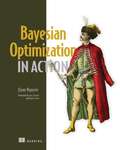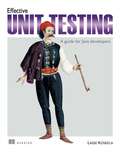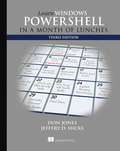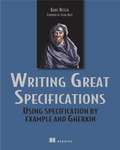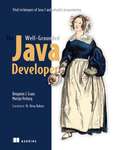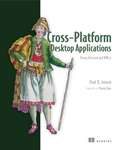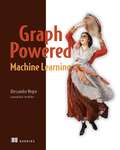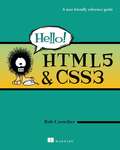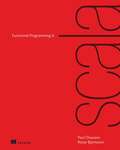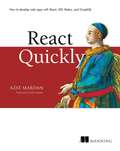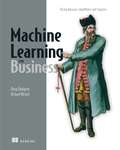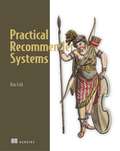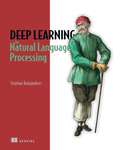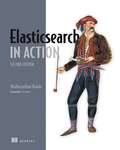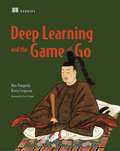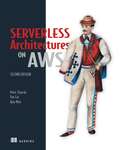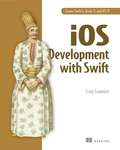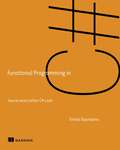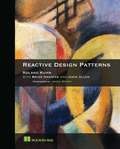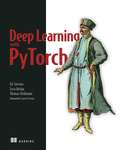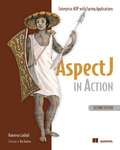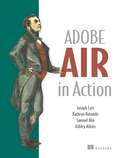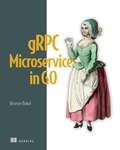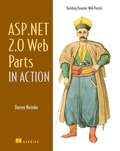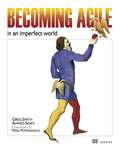- Table View
- List View
Bayesian Optimization in Action (In Action)
by Quan NguyenBayesian optimization helps pinpoint the best configuration for your machine learning models with speed and accuracy. Put its advanced techniques into practice with this hands-on guide.In Bayesian Optimization in Action you will learn how to: Train Gaussian processes on both sparse and large data sets Combine Gaussian processes with deep neural networks to make them flexible and expressive Find the most successful strategies for hyperparameter tuning Navigate a search space and identify high-performing regions Apply Bayesian optimization to cost-constrained, multi-objective, and preference optimization Implement Bayesian optimization with PyTorch, GPyTorch, and BoTorch Bayesian Optimization in Action shows you how to optimize hyperparameter tuning, A/B testing, and other aspects of the machine learning process by applying cutting-edge Bayesian techniques. Using clear language, illustrations, and concrete examples, this book proves that Bayesian optimization doesn&’t have to be difficult! You&’ll get in-depth insights into how Bayesian optimization works and learn how to implement it with cutting-edge Python libraries. The book&’s easy-to-reuse code samples let you hit the ground running by plugging them straight into your own projects. Forewords by Luis Serrano and David Sweet. About the technology In machine learning, optimization is about achieving the best predictions—shortest delivery routes, perfect price points, most accurate recommendations—in the fewest number of steps. Bayesian optimization uses the mathematics of probability to fine-tune ML functions, algorithms, and hyperparameters efficiently when traditional methods are too slow or expensive. About the book Bayesian Optimization in Action teaches you how to create efficient machine learning processes using a Bayesian approach. In it, you&’ll explore practical techniques for training large datasets, hyperparameter tuning, and navigating complex search spaces. This interesting book includes engaging illustrations and fun examples like perfecting coffee sweetness, predicting weather, and even debunking psychic claims. You&’ll learn how to navigate multi-objective scenarios, account for decision costs, and tackle pairwise comparisons. What's inside Gaussian processes for sparse and large datasets Strategies for hyperparameter tuning Identify high-performing regions Examples in PyTorch, GPyTorch, and BoTorch About the reader For machine learning practitioners who are confident in math and statistics. About the author Quan Nguyen is a research assistant at Washington University in St. Louis. He writes for the Python Software Foundation and has authored several books on Python programming. Table of Contents 1 Introduction to Bayesian optimization 2 Gaussian processes as distributions over functions 3 Customizing a Gaussian process with the mean and covariance functions 4 Refining the best result with improvement-based policies 5 Exploring the search space with bandit-style policies 6 Leveraging information theory with entropy-based policies 7 Maximizing throughput with batch optimization 8 Satisfying extra constraints with constrained optimization 9 Balancing utility and cost with multifidelity optimization 10 Learning from pairwise comparisons with preference optimization 11 Optimizing multiple objectives at the same time 12 Scaling Gaussian processes to large datasets 13 Combining Gaussian processes with neural networks
Effective Unit Testing: A guide for Java developers
by Lasse KoskelaSummaryEffective Unit Testing is written to show how to write good tests—tests that are concise and to the point, expressive, useful, and maintainable. Inspired by Roy Osherove's bestselling The Art of Unit Testing, this book focuses on tools and practices specific to the Java world. It introduces you to emerging techniques like behavior-driven development and specification by example, and shows you how to add robust practices into your toolkit.About TestingTest the components before you assemble them into a full application, and you'll get better software. For Java developers, there's now a decade of experience with well-crafted tests that anticipate problems, identify known and unknown dependencies in the code, and allow you to test components both in isolation and in the context of a full application.About this BookEffective Unit Testing teaches Java developers how to write unit tests that are concise, expressive, useful, and maintainable. Offering crisp explanations and easy-to-absorb examples, it introduces emerging techniques like behavior-driven development and specification by example.Programmers who are already unit testing will learn the current state of the art. Those who are new to the game will learn practices that will serve them well for the rest of their career. Purchase of the print book comes with an offer of a free PDF, ePub, and Kindle eBook from Manning. Also available is all code from the book. About the AuthorLasse Koskela is a coach, trainer, consultant, and programmer. He hacks on open source projects, helps companies improve their productivity, and speaks frequently at conferences around the world. Lasse is the author of Test Driven, also published by Manning.What's InsideA thorough introduction to unit testingChoosing best-of-breed toolsWriting tests using dynamic languagesEfficient test automationTable of ContentsPART 1 FOUNDATIONSThe promise of good testsIn search of goodTest doublesPART 2 CATALOGReadabilityMaintainabilityTrustworthinessPART 3 DIVERSIONSTestable designWriting tests in other JVM languagesSpeeding up test execution
Learn Windows PowerShell in a Month of Lunches
by Don JonesSummaryLearn Windows PowerShell in a Month of Lunches, Third Edition is an innovative tutorial designed for busy IT professionals. This updated edition covers PowerShell features that run on Windows 7, Windows Server 2008 R2 and later, PowerShell v3 and later, and includes v5 features like PowerShellGet.Purchase of the print book includes a free eBook in PDF, Kindle, and ePub formats from Manning Publications.About the TechnologyPowerShell is both a scripting language and an administrative shell that lets you control and automate nearly every aspect of Windows. It accepts and executes commands interactively and you can write scripts to manage most Windows servers like Exchange, IIS, and SharePoint, as well as online services like Azure and Office 365.About the BookLearn Windows PowerShell in a Month of Lunches, Third Edition is an innovative tutorial designed for busy IT professionals. Just set aside one hour a day - lunchtime would be perfect - for a month, and you'll be automating Windows tasks faster than you ever thought possible. This updated edition covers PowerShell features that run on Windows 7, Windows Server 2008 R2 and later, PowerShell v3 and later, and includes v5 features like PowerShellGet. What's InsideLearn PowerShell from the beginning, no experience required!Covers PowerShell v3 and up, Windows 7, and Windows Server 2008 R2 and laterEach lesson takes you an hour or lessAbout the ReaderExperience with Windows administration is helpful. No programming or scripting experience needed.About the AuthorVeteran PowerShell MVPs Don Jones and Jeffery Hicks bring years as successful trainers to this concise, easy-to-follow book.Table of ContentsBefore you beginMeet PowerShellUsing the help systemRunning commandsWorking with providersThe pipeline: connecting commandsAdding commandsObjects: data by another nameThe pipeline, deeperFormatting - and why it's done on the rightFiltering and comparisonsA practical interludeRemote control: one-to-one, and one-to-manyUsing Windows Management Instrumentation and CIMMultitasking with background jobsWorking with many objects, one at a timeSecurity alert!Variables: a place to store your stuffInput and outputSessions: remote control with less workYou call this scripting?Improving your parameterized scriptAdvanced remoting configurationUsing regular expressions to parse text filesAdditional random tips, tricks, and techniquesUsing someone else's scriptNever the endPowerShell cheat sheet
Writing Great Specifications: Using Specification by Example and Gherkin
by Kamil NiciejaSummaryWriting Great Specifications is an example-rich tutorial that teaches you how to write good Gherkin specification documents that take advantage of the benefits of specification by example. Foreword written by Gojko Adzic.Purchase of the print book includes a free eBook in PDF, Kindle, and ePub formats from Manning Publications.About the TechnologyThe clearest way to communicate a software specification is to provide examples of how it should work. Turning these story-based descriptions into a well-organized dev plan is another matter. Gherkin is a human-friendly, jargon-free language for documenting a suite of examples as an executable specification. It fosters efficient collaboration between business and dev teams, and it's an excellent foundation for the specification by example (SBE) process.About the BookWriting Great Specifications teaches you how to capture executable software designs in Gherkin following the SBE method. Written for both developers and non-technical team members, this practical book starts with collecting individual feature stories and organizing them into a full, testable spec. You'll learn to choose the best scenarios, write them in a way that anyone can understand, and ensure they can be easily updated by anyone.management. What's InsideReading and writing GherkinDesigning story-based test casesTeam CollaborationManaging a suite of Gherkin documentsAbout the ReaderPrimarily written for developers and architects, this book is accessible to any member of a software design team.About the AuthorKamil Nicieja is a seasoned engineer, architect, and project manager with deep expertise in Gherkin and SBE.Table of contentsIntroduction to specification by example and Gherkin PART 1 - WRITING EXECUTABLE SPECIFICATIONS WITH EXAMPLESThe specification layer and the automation layer Mastering the Given-When-Then template The basics of scenario outlines Choosing examples for scenario outlines The life cycle of executable specifications Living documentation PART 2 - MANAGING SPECIFICATION SUITES Organizing scenarios into a specification suite Refactoring features into abilities and business needs Building a domain-driven specification suite Managing large projects with bounded contexts
Arduino in Action
by Joshua Noble Martin Evans Jordan HochenbaumSummaryArduino in Action is a hands-on guide to prototyping and building electronics using the Arduino platform. Suitable for both beginners and advanced users, this easy-to-follow book begins with the basics and then systematically guides you through projects ranging from your first blinking LED through connecting Arduino to devices like game controllers or your iPhone.About the TechnologyArduino is an open source do-it-yourself electronics platform that supports a mind-boggling collection of sensors and actuators you can use to build anything you can imagine. Even if you've never attempted a hardware project, this easy-to-follow book will guide you from your first blinking LED through connecting Arduino to your iPhone.About this BookArduino in Action is a hands-on guide to prototyping and building DIY electronics. You'll start with the basics—unpacking your board and using a simple program to make something happen. Then, you'l attempt progressively more complex projects as you connect Arduino to motors, LCD displays, Wi-Fi, GPS, and Bluetooth. You'll explore input/output sensors, including ultrasound, infrared, and light, and then use them for tasks like robotic obstacle avoidance.Arduino programs look a lot like C or C++, so some programming skill is helpful.What's InsideGetting started with Arduino—no experience required!Writing programs for ArduinoSensing and responding to eventsRobots, flying vehicles, Twitter machines, LCD displays, and more!Purchase of the print book includes a free eBook in PDF, Kindle, and ePub formats from Manning Publications.About the AuthorsMartin Evans is a professional developer, a lifelong electronics enthusiast, and the creator of an Arduino-based underwater ROV. Joshua Noble is an author and creative technologist who works with smart spaces. Jordan Hochenbaum uses Arduino to explore musical expression and creative interaction.Table of ContentsPart 1 Getting startedChapter 1 Hello ArduinoChapter 2 Digital input and outputChapter 3 Simple projects: input and outputPart 2 Putting Arduino to workChapter 4 Extending ArduinoChapter 5 Arduino in motionChapter 6 Object detectionChapter 7 LCD displaysChapter 8 CommunicationsChapter 9 Game onChapter 10 Integrating the Arduino with iOSChapter 11 Making wearablesChapter 12 Adding shieldsChapter 13 Software integration
Cross-Platform Desktop Applications: Using Node, Electron, and NW.js
by Paul JensenSummaryCross-Platform Desktop Applications guides you step-by-step through creating Node.js desktop applications with NW.js and Electron from GitHub. Foreword by Cheng Zhao, creator of Electron.Purchase of the print book includes a free eBook in PDF, Kindle, and ePub formats from Manning Publications.About the TechnologyDesktop application development has traditionally required high-level programming languages and specialized frameworks. With Electron and NW.js, you can apply your existing web dev skills to create desktop applications using only HTML, CSS, and JavaScript. And those applications will work across Windows, Mac, and Linux, radically reducing development and training time.About the BookCross-Platform Desktop Applications guides you step by step through the development of desktop applications using Electron and NW.js. This example-filled guide shows you how to create your own file explorer, and then steps through some of the APIs provided by the frameworks to work with the camera, access the clipboard, make a game with keyboard controls, and build a Twitter desktop notification tool. You'll then learn how to test your applications, and debug and package them as binaries for various OSs.What's InsideCreate a selfie app with the desktop cameraLearn how to test Electron apps with DevtronLearn how to use Node.js with your applicationAbout the ReaderWritten for developers familiar with HTML, CSS, and JavaScript.About the AuthorPaul Jensen works at Starcount and lives in London, UK.Table of ContentsPART 1 - WELCOME TO NODE.JS DESKTOP APPLICATION DEVELOPMENTIntroducing Electron and NW.jsLaying the foundation for your first desktop applicationBuilding your first desktop applicationShipping your first desktop applicationPART 2 - DIVING DEEPERUsing Node.js within NW.js and ElectronExploring NW.js and Electron's internalsPART 3 - MASTERING NODE.JS DESKTOP APPLICATION DEVELOPMENTControlling how your desktop app is displayedCreating tray applicationsCreating application and context menusDragging and dropping files and crafting the UIUsing a webcam in your applicationStoring app dataCopying and pasting contents from the clipboardBinding on keyboard shortcutsMaking desktop notificationsPART 4 - GETTING READY TO RELEASETesting desktop appsImproving app performance with debuggingPackaging the application for the wider world
Graph-Powered Machine Learning
by Alessandro NegroUpgrade your machine learning models with graph-based algorithms, the perfect structure for complex and interlinked data.Summary In Graph-Powered Machine Learning, you will learn: The lifecycle of a machine learning project Graphs in big data platforms Data source modeling using graphs Graph-based natural language processing, recommendations, and fraud detection techniques Graph algorithms Working with Neo4J Graph-Powered Machine Learning teaches to use graph-based algorithms and data organization strategies to develop superior machine learning applications. You&’ll dive into the role of graphs in machine learning and big data platforms, and take an in-depth look at data source modeling, algorithm design, recommendations, and fraud detection. Explore end-to-end projects that illustrate architectures and help you optimize with best design practices. Author Alessandro Negro&’s extensive experience shines through in every chapter, as you learn from examples and concrete scenarios based on his work with real clients! Purchase of the print book includes a free eBook in PDF, Kindle, and ePub formats from Manning Publications. About the technology Identifying relationships is the foundation of machine learning. By recognizing and analyzing the connections in your data, graph-centric algorithms like K-nearest neighbor or PageRank radically improve the effectiveness of ML applications. Graph-based machine learning techniques offer a powerful new perspective for machine learning in social networking, fraud detection, natural language processing, and recommendation systems. About the book Graph-Powered Machine Learning teaches you how to exploit the natural relationships in structured and unstructured datasets using graph-oriented machine learning algorithms and tools. In this authoritative book, you&’ll master the architectures and design practices of graphs, and avoid common pitfalls. Author Alessandro Negro explores examples from real-world applications that connect GraphML concepts to real world tasks. What's inside Graphs in big data platforms Recommendations, natural language processing, fraud detection Graph algorithms Working with the Neo4J graph database About the reader For readers comfortable with machine learning basics. About the author Alessandro Negro is Chief Scientist at GraphAware. He has been a speaker at many conferences, and holds a PhD in Computer Science. Table of Contents PART 1 INTRODUCTION 1 Machine learning and graphs: An introduction 2 Graph data engineering 3 Graphs in machine learning applications PART 2 RECOMMENDATIONS 4 Content-based recommendations 5 Collaborative filtering 6 Session-based recommendations 7 Context-aware and hybrid recommendations PART 3 FIGHTING FRAUD 8 Basic approaches to graph-powered fraud detection 9 Proximity-based algorithms 10 Social network analysis against fraud PART 4 TAMING TEXT WITH GRAPHS 11 Graph-based natural language processing 12 Knowledge graphs
Hello! HTML5 & CSS3: A User Friendly Reference Guide
by Rob CrowtherSummaryHello! HTML5 & CSS3 is written for the web designer or developer who wants a fast, example-oriented introduction to the new HTML and CSS features. This snappy, user-friendly, and fun guide will get you started right away.About this BookWhether you're building web pages, mobile apps, or desktop apps, you need to learn HTML5 and CSS3. So why wait? Hello! HTML5 & CSS3 is a smart, snappy, and fun way to get started now.In this example-rich guide to HTML5 and CSS3, you'll start with a user-friendly introduction to HTML5 markup and then take a quick tour through forms, graphics, drag-and-drop, multimedia, and more. Next, you'll explore CSS3, including new features like drop shadows, borders, colors, gradients, and backgrounds. Every step of the way, you'll find hands-on examples, both large and small, to help you learn by doing. Purchase of the print book comes with an offer of a free PDF, ePub, and Kindle eBook from Manning. Also available is all code from the book.What's insideEasy-to-follow intro to HTML5 and CSS3Fully illustrated and loaded with examplesDesigned for low-stress learningNo prior experience needed!Table of ContentsPART 1 LEARNING HTML5Introducing HTML5 markupHTML5 formsDynamic graphicsAudio and videoBrowser-based APIsNetwork and location APIsPART 2 LEARNING CSS3New CSS language featuresLayout with CSS3Motion and colorBorders and backgrounds with CSS3Text and fonts
Functional Programming in Scala
by Paul Chiusano Runar BjarnasonSummaryFunctional Programming in Scala is a serious tutorial for programmers looking to learn FP and apply it to the everyday business of coding. The book guides readers from basic techniques to advanced topics in a logical, concise, and clear progression. In it, you'll find concrete examples and exercises that open up the world of functional programming.Purchase of the print book includes a free eBook in PDF, Kindle, and ePub formats from Manning Publications.About the TechnologyFunctional programming (FP) is a style of software development emphasizing functions that don't depend on program state. Functional code is easier to test and reuse, simpler to parallelize, and less prone to bugs than other code. Scala is an emerging JVM language that offers strong support for FP. Its familiar syntax and transparent interoperability with Java make Scala a great place to start learning FP. About the BookFunctional Programming in Scala is a serious tutorial for programmers looking to learn FP and apply it to their everyday work. The book guides readers from basic techniques to advanced topics in a logical, concise, and clear progression. In it, you'll find concrete examples and exercises that open up the world of functional programming.This book assumes no prior experience with functional programming. Some prior exposure to Scala or Java is helpful. What's InsideFunctional programming conceptsThe whys and hows of FPHow to write multicore programsExercises and checks for understandingAbout the AuthorsPaul Chiusano and Rúnar Bjarnason are recognized experts in functional programming with Scala and are core contributors to the Scalaz library.Table of ContentsPART 1 INTRODUCTION TO FUNCTIONAL PROGRAMMINGWhat is functional programming? Getting started with functional programming in ScalaFunctional data structuresHandling errors without exceptionsStrictness and lazinessPurely functional state PART 2 FUNCTIONAL DESIGN AND COMBINATOR LIBRARIESPurely functional parallelismProperty-based testingParser combinatorsPART 3 COMMON STRUCTURES IN FUNCTIONAL DESIGNMonoidsMonadsApplicative and traversable functorsPART 4 EFFECTS AND I/OExternal effects and I/OLocal effects and mutable stateStream processing and incremental I/O
React Quickly: Painless web apps with React, JSX, Redux, and GraphQL
by Azat MardanSummaryReact Quickly is for anyone who wants to learn React.js fast. This hands-on book teaches you the concepts you need with lots of examples, tutorials, and a large main project that gets built throughout the book. Purchase of the print book includes a free eBook in PDF, Kindle, and ePub formats from Manning Publications.About the TechnologySuccessful user interfaces need to be visually interesting, fast, and flowing. The React.js JavaScript library supercharges view-heavy web applications by improving data flow between UI components. React sites update visual elements efficiently and smoothly, minimizing page reloads. React is developer friendly, with a strong ecosystem to support the dev process along the full application stack. And because it's all JavaScript, React is instantly familiar. About the BookReact Quickly is the tutorial for web developers who want to get started fast with React.js. Following carefully chosen and clearly explained examples, you'll learn React development using your existing JavaScript and web dev skills. You'll explore a host of different projects as you learn about web components, forms, and data. What's InsideMaster React fundamentalsBuild full web apps with data and routingTest componentsOptimize React appsAbout the Reader This book is for developers comfortable building web applications with JavaScript. About the AuthorAzat Mardan is a Tech Fellow at Capital One with extensive experience using and teaching JavaScript and Node, and author of several books on JavaScript, Node, React, and Express.Table of ContensPART 1 - REACT FOUNDATIONMeeting ReactBaby steps with ReactIntroduction to JSXMaking React interactive with statesReact component lifecycle eventsHandling events in ReactWorking with forms in ReactScaling React componentsProject: Menu componentProject: Tooltip componentProject: Timer componentPART 2 - REACT ARCHITECTURE The Webpack build toolReact routingWorking with data using ReduxWorking with data using GraphQLUnit testing React with JestReact on Node and Universal JavaScriptProject: Building a bookstore with React RouterProject: Checking passwords with JestProject: Implementing autocomplete with Jest, Express, and MongoDBAPPENDIXESAppendix A - Installing applications used in this bookAppendix B - React cheatsheetAppendix C - Express.js cheatsheetAppendix D - MongoDB and Mongoose cheatsheetAppendix E - ES6 for success
Machine Learning for Business: Using Amazon SageMaker and Jupyter
by Doug Hudgeon Richard NicholSummary Imagine predicting which customers are thinking about switching to a competitor or flagging potential process failures before they happen Think about the benefits of forecasting tedious business processes and back-office tasks Envision quickly gauging customer sentiment from social media content (even large volumes of it). Consider the competitive advantage of making decisions when you know the most likely future events Machine learning can deliver these and other advantages to your business, and it&’s never been easier to get started! Purchase of the print book includes a free eBook in PDF, Kindle, and ePub formats from Manning Publications. About the technology Machine learning can deliver huge benefits for everyday business tasks. With some guidance, you can get those big wins yourself without complex math or highly paid consultants! If you can crunch numbers in Excel, you can use modern ML services to efficiently direct marketing dollars, identify and keep your best customers, and optimize back office processes. This book shows you how. About the book Machine Learning for Business teaches business-oriented machine learning techniques you can do yourself. Concentrating on practical topics like customer retention, forecasting, and back office processes, you&’ll work through six projects that help you form an ML-for-business mindset. To guarantee your success, you&’ll use the Amazon SageMaker ML service, which makes it a snap to turn your questions into results. What's inside Identifying tasks suited to machine learning Automating back office processes Using open source and cloud-based tools Relevant case studies About the reader For technically inclined business professionals or business application developers. About the author Doug Hudgeon and Richard Nichol specialize in maximizing the value of business data through AI and machine learning for companies of any size. Table of Contents: PART 1 MACHINE LEARNING FOR BUSINESS 1 ¦ How machine learning applies to your business PART 2 SIX SCENARIOS: MACHINE LEARNING FOR BUSINESS 2 ¦ Should you send a purchase order to a technical approver? 3 ¦ Should you call a customer because they are at risk of churning? 4 ¦ Should an incident be escalated to your support team? 5 ¦ Should you question an invoice sent by a supplier? 6 ¦ Forecasting your company&’s monthly power usage 7 ¦ Improving your company&’s monthly power usage forecast PART 3 MOVING MACHINE LEARNING INTO PRODUCTION 8 ¦ Serving predictions over the web 9 ¦ Case studies
Practical Recommender Systems
by Kim FalkSummaryOnline recommender systems help users find movies, jobs, restaurants-even romance! There's an art in combining statistics, demographics, and query terms to achieve results that will delight them. Learn to build a recommender system the right way: it can make or break your application!Purchase of the print book includes a free eBook in PDF, Kindle, and ePub formats from Manning Publications.About the TechnologyRecommender systems are everywhere, helping you find everything from movies to jobs, restaurants to hospitals, even romance. Using behavioral and demographic data, these systems make predictions about what users will be most interested in at a particular time, resulting in high-quality, ordered, personalized suggestions. Recommender systems are practically a necessity for keeping your site content current, useful, and interesting to your visitors.About the BookPractical Recommender Systems explains how recommender systems work and shows how to create and apply them for your site. After covering the basics, you'll see how to collect user data and produce personalized recommendations. You'll learn how to use the most popular recommendation algorithms and see examples of them in action on sites like Amazon and Netflix. Finally, the book covers scaling problems and other issues you'll encounter as your site grows.What's insideHow to collect and understand user behaviorCollaborative and content-based filteringMachine learning algorithms Real-world examples in PythonAbout the ReaderReaders need intermediate programming and database skills.About the AuthorKim Falk is an experienced data scientist who works daily with machine learning and recommender systems.Table of ContentsPART 1 - GETTING READY FOR RECOMMENDER SYSTEMSWhat is a recommender? User behavior and how to collect it Monitoring the system Ratings and how to calculate themNon-personalized recommendationsThe user (and content) who came in from the coldPART 2 - RECOMMENDER ALGORITHMSFinding similarities among users and among contentCollaborative filtering in the neighborhoodEvaluating and testing your recommenderContent-based filteringFinding hidden genres with matrix factorizationTaking the best of all algorithms: implementing hybrid recommendersRanking and learning to rankFuture of recommender systems
Deep Learning for Natural Language Processing
by Stephan RaaijmakersExplore the most challenging issues of natural language processing, and learn how to solve them with cutting-edge deep learning!Inside Deep Learning for Natural Language Processing you&’ll find a wealth of NLP insights, including: An overview of NLP and deep learning One-hot text representations Word embeddings Models for textual similarity Sequential NLP Semantic role labeling Deep memory-based NLP Linguistic structure Hyperparameters for deep NLP Deep learning has advanced natural language processing to exciting new levels and powerful new applications! For the first time, computer systems can achieve "human" levels of summarizing, making connections, and other tasks that require comprehension and context. Deep Learning for Natural Language Processing reveals the groundbreaking techniques that make these innovations possible. Stephan Raaijmakers distills his extensive knowledge into useful best practices, real-world applications, and the inner workings of top NLP algorithms. About the technology Deep learning has transformed the field of natural language processing. Neural networks recognize not just words and phrases, but also patterns. Models infer meaning from context, and determine emotional tone. Powerful deep learning-based NLP models open up a goldmine of potential uses. About the book Deep Learning for Natural Language Processing teaches you how to create advanced NLP applications using Python and the Keras deep learning library. You&’ll learn to use state-of the-art tools and techniques including BERT and XLNET, multitask learning, and deep memory-based NLP. Fascinating examples give you hands-on experience with a variety of real world NLP applications. Plus, the detailed code discussions show you exactly how to adapt each example to your own uses! What's inside Improve question answering with sequential NLP Boost performance with linguistic multitask learning Accurately interpret linguistic structure Master multiple word embedding techniques About the reader For readers with intermediate Python skills and a general knowledge of NLP. No experience with deep learning is required. About the author Stephan Raaijmakers is professor of Communicative AI at Leiden University and a senior scientist at The Netherlands Organization for Applied Scientific Research (TNO). Table of Contents PART 1 INTRODUCTION 1 Deep learning for NLP 2 Deep learning and language: The basics 3 Text embeddings PART 2 DEEP NLP 4 Textual similarity 5 Sequential NLP 6 Episodic memory for NLP PART 3 ADVANCED TOPICS 7 Attention 8 Multitask learning 9 Transformers 10 Applications of Transformers: Hands-on with BERT
Elasticsearch in Action, Second Edition (In Action)
by Madhusudhan KondaBuild powerful, production-ready search applications using the incredible features of Elasticsearch.In Elasticsearch in Action, Second Edition you will discover: Architecture, concepts, and fundamentals of Elasticsearch Installing, configuring, and running Elasticsearch and Kibana Creating an index with custom settings Data types, mapping fundamentals, and templates Fundamentals of text analysis and working with text analyzers Indexing, deleting, and updating documents Indexing data in bulk, and reindexing and aliasing operations Learning search concepts, relevancy scores, and similarity algorithms Elasticsearch in Action, Second Edition teaches you to build scalable search applications using Elasticsearch. This completely new edition explores Elasticsearch fundamentals from the ground up. You&’ll deep dive into design principles, search architectures, and Elasticsearch&’s essential APIs. Every chapter is clearly illustrated with diagrams and hands-on examples. You&’ll even explore real-world use cases for full text search, data visualizations, and machine learning. Plus, its comprehensive nature means you&’ll keep coming back to the book as a handy reference! Foreword by Shay Banon. About the technology Create fully professional-grade search engines with Elasticsearch and Kibana! Rewritten for the latest version of Elasticsearch, this practical book explores Elasticsearch&’s high-level architecture, reveals infrastructure patterns, and walks through the search and analytics capabilities of numerous Elasticsearch APIs. About the book Elasticsearch in Action, Second Edition teaches you how to add modern search features to websites and applications using Elasticsearch 8. In it, you&’ll quickly progress from the basics of installation and configuring clusters, to indexing documents, advanced aggregations, and putting your servers into production. You&’ll especially appreciate the mix of technical detail with techniques for designing great search experiences. What's inside Understanding search architecture Full text and term-level search queries Analytics and aggregations High-level visualizations in Kibana Configure, scale, and tune clusters About the reader For application developers comfortable with scripting and command-line applications. About the author Madhusudhan Konda is a full-stack lead engineer, architect, mentor, and conference speaker. He delivers live online training on Elasticsearch and the Elastic Stack. Table of Contents 1 Overview 2 Getting started 3 Architecture 4 Mapping 5 Working with documents 6 Indexing operations 7 Text analysis 8 Introducing search 9 Term-level search 10 Full-text searches 11 Compound queries 12 Advanced search 13 Aggregations 14 Administration 15 Performance and troubleshooting
Deep Learning and the Game of Go
by Max Pumperla Kevin FergusonSummaryDeep Learning and the Game of Go teaches you how to apply the power of deep learning to complex reasoning tasks by building a Go-playing AI. After exposing you to the foundations of machine and deep learning, you'll use Python to build a bot and then teach it the rules of the game.Foreword by Thore Graepel, DeepMindPurchase of the print book includes a free eBook in PDF, Kindle, and ePub formats from Manning Publications.About the TechnologyThe ancient strategy game of Go is an incredible case study for AI. In 2016, a deep learning-based system shocked the Go world by defeating a world champion. Shortly after that, the upgraded AlphaGo Zero crushed the original bot by using deep reinforcement learning to master the game. Now, you can learn those same deep learning techniques by building your own Go bot!About the BookDeep Learning and the Game of Go introduces deep learning by teaching you to build a Go-winning bot. As you progress, you'll apply increasingly complex training techniques and strategies using the Python deep learning library Keras. You'll enjoy watching your bot master the game of Go, and along the way, you'll discover how to apply your new deep learning skills to a wide range of other scenarios!What's insideBuild and teach a self-improving game AIEnhance classical game AI systems with deep learningImplement neural networks for deep learningAbout the ReaderAll you need are basic Python skills and high school-level math. No deep learning experience required.About the AuthorMax Pumperla and Kevin Ferguson are experienced deep learning specialists skilled in distributed systems and data science. Together, Max and Kevin built the open source bot BetaGo.Table of ContentsPART 1 - FOUNDATIONSToward deep learning: a machine-learning introductionGo as a machine-learning problemImplementing your first Go botPART 2 - MACHINE LEARNING AND GAME AIPlaying games with tree searchGetting started with neural networksDesigning a neural network for Go dataLearning from data: a deep-learning botDeploying bots in the wildLearning by practice: reinforcement learningReinforcement learning with policy gradientsReinforcement learning with value methodsReinforcement learning with actor-critic methodsPART 3 - GREATER THAN THE SUM OF ITS PARTSAlphaGo: Bringing it all togetherAlphaGo Zero: Integrating tree search with reinforcement learning
Serverless Architectures on AWS, Second Edition
by Yan Cui Peter Sbarski Ajay NairDesign low-maintenance systems using pre-built cloud services! Bring down costs, automate time-consuming ops tasks, and scale on demand.In Serverless Architectures on AWS, Second Edition you will learn: First steps with serverless computing The principles of serverless design Important patterns and architectures How successfully companies have implemented serverless Real-world architectures and their tradeoffs Serverless Architectures on AWS, Second Edition teaches you how to design serverless systems. You&’ll discover the principles behind serverless architectures, and explore real-world case studies where companies used serverless architectures for their products. You won&’t just master the technical essentials—the book contains extensive coverage of balancing tradeoffs and making essential technical decisions. This new edition has been fully updated with new chapters covering current best practice, example architectures, and full coverage of the latest changes to AWS. About the technology Maintaining server hardware and software can cost a lot of time and money. Unlike traditional data center infrastructure, serverless architectures offload core tasks like data storage and hardware management to pre-built cloud services. Better yet, you can combine your own custom AWS Lambda functions with other serverless services to create features that automatically start and scale on demand, reduce hosting cost, and simplify maintenance. About the book In Serverless Architectures with AWS, Second Edition you&’ll learn how to design serverless systems using Lambda and other services on the AWS platform. You&’ll explore event-driven computing and discover how others have used serverless designs successfully. This new edition offers real-world use cases and practical insights from several large-scale serverless systems. Chapters on innovative serverless design patterns and architectures will help you become a complete cloud professional. What's inside First steps with serverless computing The principles of serverless design Important patterns and architectures Real-world architectures and their tradeoffs About the reader For server-side and full-stack software developers. About the author Peter Sbarski is VP of Education and Research at A Cloud Guru. Yan Cui is an independent AWS consultant and educator. Ajay Nair is one of the founding members of the AWS Lambda team. Table of Contents PART 1 FIRST STEPS 1 Going serverless 2 First steps to serverless 3 Architectures and patterns PART 2 USE CASES 4 Yubl: Architecture highlights, lessons learned 5 A Cloud Guru: Architecture highlights, lessons learned 6 Yle: Architecture highlights, lessons learned PART 3 PRACTICUM 7 Building a scheduling service for ad hoc tasks 8 Architecting serverless parallel computing 9 Code Developer University PART 4 THE FUTURE 10 Blackbelt Lambda 11 Emerging practices
iOS Development with Swift
by Craig GrummittSummaryiOS Development with Swift is a hands-on guide to creating apps for iPhone and iPad using the Swift language. Inside, you'll be guided through every step of the process for building an app, from first idea to App Store. This book fully covers Swift 4, Xcode 9, and iOS 1.Our video course, iOS Development with Swift in Motion, is the perfect companion to this book, featuring even more projects and examples for you to dig into in the exciting world of iOS development. Find out more at our website: www.manning.com/livevideo/ios-development-with-swift-lvPurchase of the print book includes a free eBook in PDF, Kindle, and ePub formats from Manning Publications.About the TechnologyOne billion iPhone users are waiting for the next amazing app. It's time for you to build it! Apple's Swift language makes iOS development easier than ever, offering modern language features, seamless integration with all iOS libraries, and the top-notch Xcode development environment. And with this book, you'll get started fast.About the BookiOS Development with Swift is a hands-on guide to creating iOS apps. It takes you through the experience of building an app—from idea to App Store. After setting up your dev environment, you'll learn the basics by experimenting in Swift playgrounds. Then you'll build a simple app layout, adding features like animations and UI widgets. Along the way, you'll retrieve, format, and display data; interact with the camera and other device features; and touch on cloud and networking basics. What's InsideCreate adaptive layoutsStore and manage dataLearn to write and debug Swift codePublish to the App StoreCovers Swift 4, Xcode 9, and iOS 11About the ReaderWritten for intermediate web or mobile developers. No prior experience with Swift assumed.About the AuthorCraig Grummitt is a successful developer, instructor, and mentor. His iOS apps have had over 100,000 downloads combined!Table of ContentsPART 1 - INTRODUCING XCODE AND SWIFT Your first iOS application Introduction to Swift playgrounds Swift objects PART 2 - BUILDING YOUR INTERFACE View controllers, views, and outlets User interaction Adaptive layout More adaptive layout Keyboard notifications, animation, and scrolling PART 3 - BUILDING YOUR APP Tables and navigation Collections, searching, sorting, and tab bars Local data persistence Data persistence in iCloud Graphics and media Networking Debugging and testingPART 4 - FINALIZING YOUR APP Distributing your app What's next?
Functional Programming in C#: How to write better C# code
by Enrico BuonannoSummaryFunctional Programming in C# teaches you to apply functional thinking to real-world problems using the C# language. The book, with its many practical examples, is written for proficient C# programmers with no prior FP experience. It will give you an awesome new perspective.Purchase of the print book includes a free eBook in PDF, Kindle, and ePub formats from Manning Publications.About the TechnologyFunctional programming changes the way you think about code. For C# developers, FP techniques can greatly improve state management, concurrency, event handling, and long-term code maintenance. And C# offers the flexibility that allows you to benefit fully from the application of functional techniques. This book gives you the awesome power of a new perspective.About the BookFunctional Programming in C# teaches you to apply functional thinking to real-world problems using the C# language. You'll start by learning the principles of functional programming and the language features that allow you to program functionally. As you explore the many practical examples, you'll learn the power of function composition, data flow programming, immutable data structures, and monadic composition with LINQ.What's InsideWrite readable, team-friendly codeMaster async and data streamsRadically improve error handlingEvent sourcing and other FP patternsAbout the ReaderWritten for proficient C# programmers with no prior FP experience.About the AuthorEnrico Buonanno studied computer science at Columbia University and has 15 years of experience as a developer, architect, and trainer.Table of ContentsPART 1 - CORE CONCEPTSIntroducing functional programmingWhy function purity matters Designing function signatures and types Patterns in functional programming Designing programs with function composition PART 2 - BECOMING FUNCTIONALFunctional error handling Structuring an application with functions Working effectively with multi-argument functions Thinking about data functionally Event sourcing: a functional approach to persistence PART 3 - ADVANCED TECHNIQUESLazy computations, continuations, and the beauty of monadic composition Stateful programs and stateful computations Working with asynchronous computations Data streams and the Reactive Extensions An introduction to message-passing concurrency
Reactive Design Patterns
by Jamie AllenSummaryReactive Design Patterns is a clearly written guide for building message-driven distributed systems that are resilient, responsive, and elastic. In this book you'll find patterns for messaging, flow control, resource management, and concurrency, along with practical issues like test-friendly designs. All patterns include concrete examples using Scala and Akka. Foreword by Jonas Bonér. Purchase of the print book includes a free eBook in PDF, Kindle, and ePub formats from Manning Publications.About the TechnologyModern web applications serve potentially vast numbers of users - and they need to keep working as servers fail and new ones come online, users overwhelm limited resources, and information is distributed globally. A Reactive application adjusts to partial failures and varying loads, remaining responsive in an ever-changing distributed environment. The secret is message-driven architecture - and design patterns to organize it.About the BookReactive Design Patterns presents the principles, patterns, and best practices of Reactive application design. You'll learn how to keep one slow component from bogging down others with the Circuit Breaker pattern, how to shepherd a many-staged transaction to completion with the Saga pattern, how to divide datasets by Sharding, and more. You'll even see how to keep your source code readable and the system testable despite many potential interactions and points of failure. What's InsideThe definitive guide to the Reactive ManifestoPatterns for flow control, delimited consistency, fault tolerance, and much moreHard-won lessons about what doesn't workArchitectures that scale under tremendous loadAbout the ReaderMost examples use Scala, Java, and Akka. Readers should be familiar with distributed systems.About the AuthorDr. Roland Kuhn led the Akka team at Lightbend and coauthored the Reactive Manifesto. Brian Hanafee and Jamie Allen are experienced distributed systems architects. Table of ContentsPART 1 - INTRODUCTIONWhy Reactive? A walk-through of the Reactive Manifesto Tools of the trade PART 2 - THE PHILOSOPHY IN A NUTSHELLMessage passing Location transparency Divide and conquer Principled failure handling Delimited consistency Nondeterminism by need Message flow PART 3 - PATTERNS Testing reactive applications Fault tolerance and recovery patterns Replication patterns Resource-management patterns Message flow patterns Flow control patterns State management and persistence patterns
Deep Learning with PyTorch
by Luca Pietro Antiga Eli Stevens Thomas Viehmann&“We finally have the definitive treatise on PyTorch! It covers the basics and abstractions in great detail. I hope this book becomes your extended reference document.&” —Soumith Chintala, co-creator of PyTorch Key Features Written by PyTorch&’s creator and key contributors Develop deep learning models in a familiar Pythonic way Use PyTorch to build an image classifier for cancer detection Diagnose problems with your neural network and improve training with data augmentation Purchase of the print book includes a free eBook in PDF, Kindle, and ePub formats from Manning Publications.About The Book Every other day we hear about new ways to put deep learning to good use: improved medical imaging, accurate credit card fraud detection, long range weather forecasting, and more. PyTorch puts these superpowers in your hands. Instantly familiar to anyone who knows Python data tools like NumPy and Scikit-learn, PyTorch simplifies deep learning without sacrificing advanced features. It&’s great for building quick models, and it scales smoothly from laptop to enterprise. Deep Learning with PyTorch teaches you to create deep learning and neural network systems with PyTorch. This practical book gets you to work right away building a tumor image classifier from scratch. After covering the basics, you&’ll learn best practices for the entire deep learning pipeline, tackling advanced projects as your PyTorch skills become more sophisticated. All code samples are easy to explore in downloadable Jupyter notebooks. What You Will Learn Understanding deep learning data structures such as tensors and neural networks Best practices for the PyTorch Tensor API, loading data in Python, and visualizing results Implementing modules and loss functions Utilizing pretrained models from PyTorch Hub Methods for training networks with limited inputs Sifting through unreliable results to diagnose and fix problems in your neural network Improve your results with augmented data, better model architecture, and fine tuning This Book Is Written For For Python programmers with an interest in machine learning. No experience with PyTorch or other deep learning frameworks is required. About The Authors Eli Stevens has worked in Silicon Valley for the past 15 years as a software engineer, and the past 7 years as Chief Technical Officer of a startup making medical device software. Luca Antiga is co-founder and CEO of an AI engineering company located in Bergamo, Italy, and a regular contributor to PyTorch. Thomas Viehmann is a Machine Learning and PyTorch speciality trainer and consultant based in Munich, Germany and a PyTorch core developer. Table of Contents PART 1 - CORE PYTORCH 1 Introducing deep learning and the PyTorch Library 2 Pretrained networks 3 It starts with a tensor 4 Real-world data representation using tensors 5 The mechanics of learning 6 Using a neural network to fit the data 7 Telling birds from airplanes: Learning from images 8 Using convolutions to generalize PART 2 - LEARNING FROM IMAGES IN THE REAL WORLD: EARLY DETECTION OF LUNG CANCER 9 Using PyTorch to fight cancer 10 Combining data sources into a unified dataset 11 Training a classification model to detect suspected tumors 12 Improving training with metrics and augmentation 13 Using segmentation to find suspected nodules 14 End-to-end nodule analysis, and where to go next PART 3 - DEPLOYMENT 15 Deploying to production
AspectJ in Action: Enterprise AOP with Spring Applications
by Raminvas LaddadTo allow the creation of truly modular software, OOP has evolved into aspect-oriented programming. AspectJ is a mature AOP implementation for Java, now integrated with Spring.AspectJ in Action, Second Edition is a fully updated, major revision of Ramnivas Laddad's best-selling first edition. It's a hands-on guide for Java developers. After introducing the core principles of AOP, it shows you how to create reusable solutions using AspectJ 6 and Spring 3. You'll master key features including annotation-based syntax, load-time weaver, annotation-based crosscutting, and Spring-AspectJ integration. Building on familiar technologies such as JDBC, Hibernate, JPA, Spring Security, Spring MVC, and Swing, you'll apply AOP to common problems encountered in enterprise applications.This book requires no previous experience in AOP and AspectJ, but it assumes you're familiar with OOP, Java, and the basics of Spring."Clear, concisely worded, well-organized ... a pleasure to read."-From the Foreword by Rod Johnson, Creator of the Spring Framework"This book teaches you how to think in aspects. It is essential reading for both beginners who know nothing about AOP and experts who think they know it all."- Andrew Eisenberg, AspectJ Development Tools Project Committer"Ramnivas showcases how to get the best out of AspectJ and Spring."-Andy Clement, AspectJ Project Lead"One of the best Java books in years."-Andrew Rhine, Software Engineer, eSecLending"By far the best reference for Spring AOP and AspectJ."-Paul Benedict, Software Engineer, Argus Health Systems"Ramnivas expertly demystifies the awesome power of aspect-oriented programming."-Craig Walls, author of Spring in Action
Adobe AIR in Action
by Ashley Atkins Samuel Ahn Joseph Lott Kathryn RotondoAdobe AIR is one of the hottest topics in rich application development. This exciting new technology is still in beta, but it's already being adopted by such web giants as eBay. With AIR, Web developers use their existing skills to build rich applications that flow seamlessly between the internet and the desktop.Adobe AIR in Action introduces AIR to developers familiar with Flex and JavaScript, showing them how to build solid AIR-driven desktop and hybrid applications. Using small examples, the expert authors walk web developers through the new topics they will need to develop AIR applications for the desktop. Readers will learn the essential features of the AIR API with examples and code samples that web professionals can use to get up and running in AIR quickly. The book describes how to create and customize native windows, read and write files and folders on the local file system.Web developers who read this book will be able to take instant advantage of the increased resources available to desktop applications. Sometimes-connected, web-enabled applications are gaining in popularity, and web developers of all stripes will want to add these skills to their toolbox. Purchase of the print book comes with an offer of a free PDF, ePub, and Kindle eBook from Manning. Also available is all code from the book.
gRPC Microservices in Go
by Hüseyin BabalBuild super fast and super secure microservices with the gRPC high-performance messaging protocol and powerful Go language.In gRPC Microservices in Go you&’ll learn: Designing and implementing resilient microservice architecture Testing microservices Deploying microservices to the cloud with modern orchestration tools Monitoring and overseeing microservices The powerful gRPC Remote Procedure Call framework delivers superior speed and security over protocols like REST. When paired with Golang&’s low-level efficiency and flexibility, gRPC and Go become a killer combination for latency-sensitive microservices applications. gRPC Microservices in Go shows you how to utilize these powerful tools to build production-grade microservices. You&’ll learn to develop microservice inter-service communication patterns that are powered by gRPC, design backward compatible APIs, and apply hexagonal architecture to microservices. About the technology Go is perfect for writing fast, reliable microservices code, but that&’s only half the story. You also need a communications framework like gRPC to connect your services and handle load balancing, tracing, health checking, and authentication. Together, Go and gRPC accelerate the development process and eliminate many of the challenges you face when building and deploying microservices. About the book gRPC Microservices in Go teaches you how to build production-ready microservices using Go and gRPC. In it, you&’ll learn to create efficient APIs in Go, use gRPC for network communication, and deploy on cloud and Kubernetes. Helpful examples, including a complete eCommerce web app, make it easy to grasp each concept. You&’ll also get an inside look at testing, deployment, and efficient DevOps practices for microservices. What's inside Designing and implementing resilient microservice architecture Testing microservices Cloud deploying microservices with orchestration tools Monitoring and overseeing microservices About the reader For software developers who know the basics of Go. About the author Hüseyin Babal has been using Go in production since 2017 to build and maintain SaaS platforms. Table of Contents PART 1 - GRPC AND MICROSERVICES ARCHITECTURE 1 Introduction to Go gRPC microservices 2 gRPC meets microservices PART 2 - DEVELOPING, TESTING, AND DEPLOYING A GRPC MICROSERVICE APPLICATION 3 Getting up and running with gRPC and Golang 4 Microservice project setup 5 Interservice communication 6 Resilient communication 7 Testing microservices 8 Deployment PART 3 - GRPC AND MICROSERVICES ARCHITECTURE 9 Observability
ASP.NET 2.0 Web Parts in Action: Building Dynamic Web Portals
by Darren NeimkeA must-buy for every ASP.NET developer using Web Parts.Scott GuthrieGeneral ManagerMicrosoft Developer Division"Squeezes the full potential out of ASP.NET Web Parts."Andres SanabriaLead Program ManagerASP.NET and Server Application FrameworksUsing Web Parts, ASP.NET developers can create portals with the same advanced features found in sites such as Live.com and Google ig.ASP.NET 2.0 Web Parts in Action demystifies portal design, development, maintenance, and deployment. In over 400 code-packed pages, ASP.NET expert Darren Neimke shares his deep understanding of the controls and services that make up the portal framework.This book will help you to code like a guru but think like a user. For example, you'll discover how to use Web Parts to reduce four-step actions to a single click with a strategically-placed edit button. Learn to balance features and usability to make your portals both look good and work well.ASP.NET 2.0 Web Parts in Action gives you the tools you need to move your ideas off the whiteboard and bring them to life. Find out how to provide the personalization options your users want while preserving the look and feel of your portals with solid designs and custom chrome. Create usable information dashboards and tackle tough interoperability questions with confidence.All the information in this book is performance-tested. Author Darren Neimke walks you through Web Parts concepts including static and dynamic connections, WebPartManager, SQLPersonalizationProvider, and the hot new ASP.NET Atlas framework.Whether you're creating custom solutions or adding Web Parts to SharePoint 2007, exploring Atlas or dabbling in gadgets, ASP.NET 2.0 Web Parts in Action will get you started and guide you as you build successful portals using ASP.NET Web Parts. Purchase of the print book comes with an offer of a free PDF, ePub, and Kindle eBook from Manning. Also available is all code from the book.
Becoming Agile: ...in an imperfect world
by Greg Smith Ahmed SidkyMany books discuss Agile from a theoretical or academic perspective. Becoming Agile takes a different approach and focuses on explaining Agile from a case-study perspective. Agile principles are discussed, explained, and then demonstrated in the context of a case study that flows throughout the book. The case study is based on a mixture of the author's real-world experiences.Becoming Agile also focuses on the importance of adapting Agile principles to the realities of your environment. In the early days of Agile, there was a general belief that Agile had to be used in all phases of a project, and that it had to be used in its purest form. Over the last few years, reputable Agile authorities have begun questioning this belief: We're finding that the best deployments of Agile are customized to the realities of a given company.Becoming Agile discusses the cultural realities of deploying Agile and how to deal with the needs of executives, managers, and the development team during migration. The author discusses employee motivation and establishing incentives that reward support of Agile techniques. Purchase of the print book comes with an offer of a free PDF, ePub, and Kindle eBook from Manning. Also available is all code from the book. Praise for Becoming Agile..."This is much more than just a book about Agile. This is a roadmap. A very detailed roadmap that takes you from the initial "is Agile right for me?" stage through completion and delivery of your pilot project and beyond."-Charlie Griefer, Senior Software Engineer, Amcom Technology"...a must read for those of us who have come from years of waterfall and attempts at changes to "traditional" methodologies or processes... clear, concise and has plenty of example scenarios that many individuals and corporations would identify with."-Jamie Phillips, Senior Software Engineer, Picis Inc"This book is quite unique. It is written in a form of a 5-day training course. I am usually not a fan of such a writing style, but I think that Becoming Agile is an exception. It's about a software process and as such requires a lot of case studies, group exercises (or at least what a book format allows), and therefore the training course style is perfect to facilitate learning."-Vladimir Pasman, Cocoacast.com"Becoming Agile in an Imperfect World offers a different and useful look at Agile methods. Reminding us that becoming agile is more of a mindset adjustment than a process change, Sidky and Smith use a case study to share their insights and tools throughout the book, including the unique Sidky Agile Measurement Index (SAMI)."-Sanjiv Augustine, President, LitheSpeed LLC and author of Managing Agile Projects"The authors emphasise that the aim should be to create a customised agile development process that is tailored to the needs of the organisation...Instead of aiming for "agile perfection", one should aim at reaching the right level of agility for one's organisation. Excellent advice!"-Kailash Awati, Eight to Late"The book totally inspired me. A lot of my readings on Agile from back in the day were very theoretical and high level at the same time. But Becoming Agile helps take you to the next level by going beyond the theory and into the nitty gritty practicality of employing the Agile approach. So it was very energizing having the game plan laid out in front of you, as well as the hurdles you'll encounter and how to overcome them."-Tariq Ahmed, author of Flex 3 in Action
